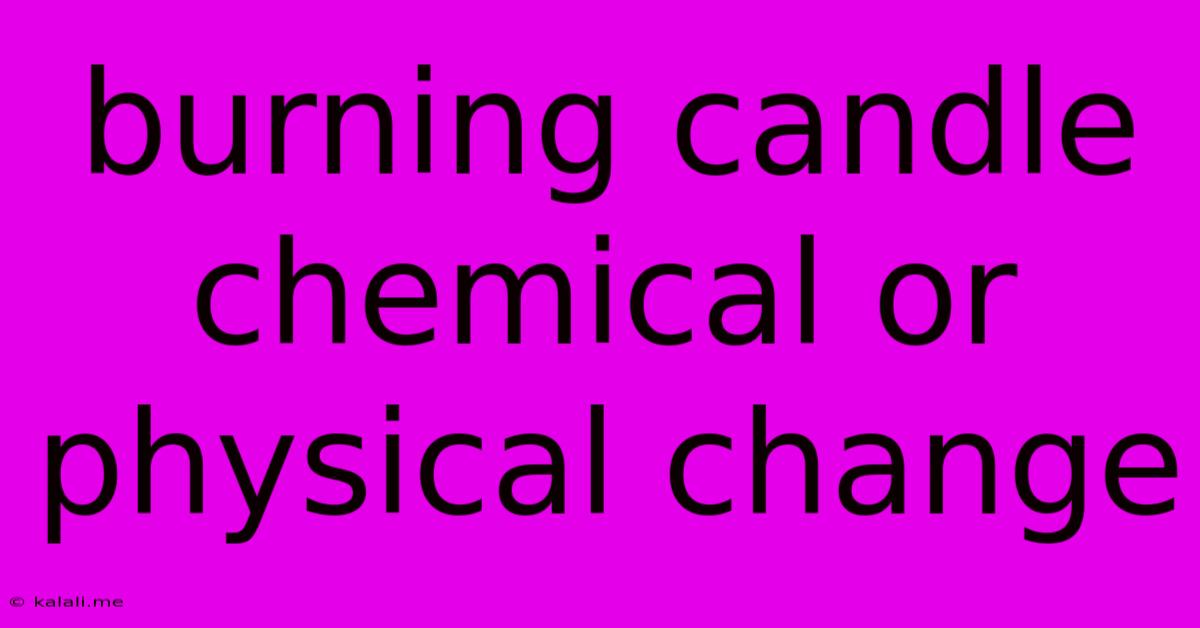Burning Candle Chemical Or Physical Change
Kalali
Jun 15, 2025 · 3 min read

Table of Contents
Burning a Candle: A Chemical Change Explained
Is burning a candle a chemical or physical change? The answer, while seemingly simple, reveals a fascinating world of chemical reactions. This article will delve into the science behind a burning candle, explaining why it's definitively a chemical change, and exploring the fascinating chemical processes involved. Understanding this will not only satisfy your curiosity but also enhance your understanding of basic chemistry.
Burning a candle involves a complex series of chemical reactions that fundamentally alter the substance's composition, resulting in entirely new substances. This transformation is the hallmark of a chemical change, differentiating it from a physical change, which only alters the form or appearance of a substance without changing its chemical identity.
The Chemistry of Candle Burning: A Closer Look
A candle is primarily composed of paraffin wax, a hydrocarbon mixture, and a wick, typically made of cotton or other natural fibers. When you light a candle, the heat from the flame melts the wax near the wick. This melted wax is then drawn up the wick through capillary action.
The heat from the flame vaporizes the liquid wax, converting it into a gaseous state. This wax vapor then mixes with oxygen from the surrounding air. This mixture of wax vapor and oxygen is highly combustible.
The combustion process is the key to understanding why burning a candle is a chemical change. Combustion is a rapid chemical reaction between a substance and an oxidant (in this case, oxygen), typically producing heat and light. In the case of a candle, the paraffin wax reacts with oxygen in a highly exothermic reaction (releasing energy as heat and light).
The chemical reaction produces several new substances:
- Carbon dioxide (CO2): A product of the complete combustion of the hydrocarbon wax.
- Water (H2O): Also a product of complete combustion.
- Heat and light: Energy released during the exothermic reaction.
- Soot (carbon): Produced if the combustion is incomplete due to insufficient oxygen. This is why you sometimes see a black smoke coming from a candle flame.
Why it's not a physical change
A physical change simply alters the form of a substance. For example, melting the wax is a physical change—the wax changes from solid to liquid but remains chemically the same. However, once the wax vapor reacts with oxygen, forming carbon dioxide and water, it undergoes a fundamental change in its chemical composition. This creation of entirely new substances is the defining characteristic of a chemical change.
Key Differences: Chemical vs. Physical Change
Let's summarize the key differences to reinforce the concept:
| Feature | Chemical Change (Burning Candle) | Physical Change (Melting Wax) |
|---|---|---|
| Composition | Changes fundamentally | Remains the same |
| New Substances | Formed (CO2, H2O, soot) | Not formed |
| Reversibility | Irreversible | Reversible (solidifies upon cooling) |
| Energy Changes | Usually involves energy release or absorption | Usually involves minimal energy changes |
Conclusion: The Irreversible Transformation
Burning a candle is undoubtedly a chemical change. The reaction of the paraffin wax with oxygen produces entirely new substances with different chemical compositions and properties. This irreversible process releases energy in the form of heat and light, further confirming its chemical nature. Understanding this basic chemical reaction provides a clear example of chemical change and the fascinating science behind everyday phenomena.
Latest Posts
Latest Posts
-
Los Angeles City College Acceptance Rate
Jun 15, 2025
-
What Is The Lcm Of 15 And 4
Jun 15, 2025
-
Which Statement Is True About Viruses
Jun 15, 2025
-
Which Teeth Have The Longest Roots
Jun 15, 2025
-
The Inertia Of An Object Depends On Its
Jun 15, 2025
Related Post
Thank you for visiting our website which covers about Burning Candle Chemical Or Physical Change . We hope the information provided has been useful to you. Feel free to contact us if you have any questions or need further assistance. See you next time and don't miss to bookmark.